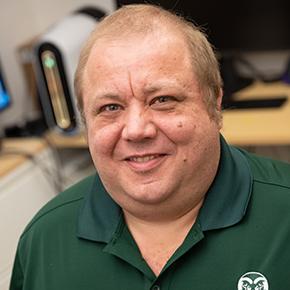|
|

|
Computer Science Department Colloquium
Towards Multimodal Interaction for Augmented and Virtual Reality and Beyond
Speaker:
Francisco Ortega, Assistant Professor, Department of Computer Science, Colorado State University
When: 11:00AM ~ 11:50AM, Monday February 26, 2024
Where: CSB 130 
Abstract: Dr. Ortega’s presentation will cover some of the research areas he has conducted over 5 ½ years at Colorado State University. The talk will describe completed and ongoing efforts and directions for the next 5-10 years. One of Dr. Ortega’s primary research areas focuses on multimodal interaction (gesture-centric), a critical component in his view of realizing everyday augmented reality (AR). While controllers remain the most common way to interact in virtual reality (VR), AR (and some VR) head-mounted displays (HMDs) include mid-air gesture interactions where the user extends their arm to interact with the virtual scene. Some systems include basic multimodal interaction (e.g., gaze + gesture pinch). However, rich multimodal interaction in AR ⁄ VR still requires additional studies to deliver intuitive 3D user interfaces for virtual environments and everyday applications. The design of multimodal and unimodal interaction is key to developing new experiences and expanding access to the "Invisible Computer" – a long-term dream of the late Dr. Weiser. In addition to Dr. Ortega’s multimodal interaction research, he will briefly describe some highlights of the other areas he currently pursues, including notifications and VR forest bathing. Dr. Ortega will also cover some lessons learned that may be useful to other researchers.
Bio: Francisco R. Ortega is an Assistant Professor at Colorado State University (CSU) and has been Director of the Natural User Interaction lab (NUILAB) since Fall 2018. Dr. Ortega earned his Ph.D. in Computer Science (CS) in the field of Human-Computer Interaction (HCI) and 3D User Interfaces (3DUI) from Florida International University (FIU). He also held the Post-Doc and Visiting Assistant Professor position at FIU between February 2015 and July 2018. His research has focused on (1) multimodal and unimodal interaction (gesture-centric), which includes gesture elicitation (e.g., a form of participatory design), (2) information access effort in augmented reality (e.g., visual cues and automation bias), (3) AR notifications, and (4) stress reduction using virtual reality forest bathing. For multimodal interaction research, Dr. Ortega focuses on improving user interaction by (a) multimodal elicitation, (b) developing interactive techniques, and (c) improving augmented reality visualization techniques. The primary domains for interaction include general environments, immersive analytics, and VR sketching. His research has resulted in over 90 peer-reviewed publications, including books, journals, conferences, workshops, and magazine articles, in venues such as ACM CHI, ACM VRST, IEEE VR, IEEE TVCG, IEEE ISMAR, ACM PACMHCI, ACM ISS, ACM SUI, IEEE 3DUI, HFES, and Human Factor Journals, among others. Dr. Ortega has experience with multiple projects awarded by the government. For example, Dr. Ortega was a co-PI for the DARPA Communicating with Computers project. He is a PI for a 3-year effort for ONR titled Perceptual ⁄ Cognitive Aspects of Augmented Reality: Experimental Research and a Computational Model. He was recently awarded a new ONR grant titled “Assessing Cognitive Load and Managing Extraneous Load to Optimize Training.” The National Science Foundation and other agencies and companies have also funded him. This includes the NSF CAREER 2023 for microgestures and multimodal interaction. Since his tenure-track appointment at CSU in August 2018, Dr. Ortega has brought over 4.2 million dollars in external funding (with 3.7 million as principal investigator). Finally, Dr. Ortega is committed to diversity and inclusion, and his mission is to increase the number of underrepresented minorities in CS, rooted in his own experiences and from the time spent at FIU – the largest R1 Hispanic serving institution.
|

